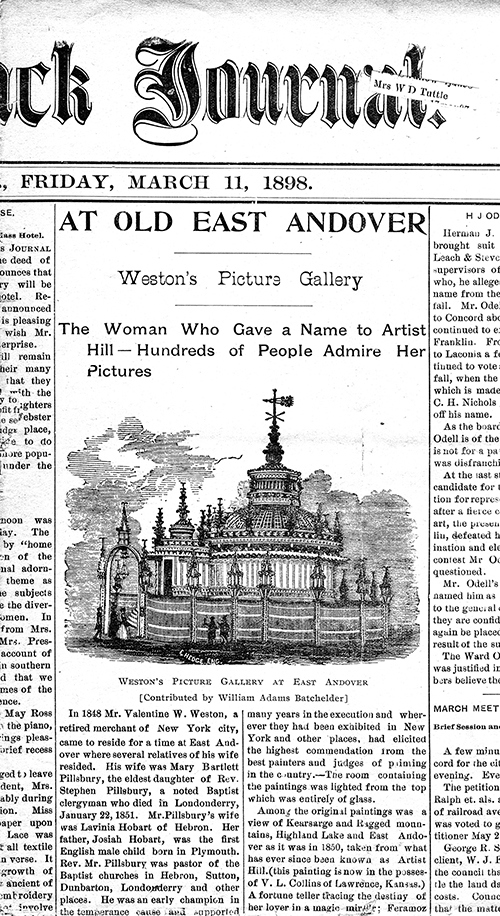
In the 1840s, Mary Weston, the artistic daughter of a Hebron, New Hampshire Baptist minister, moved to East Andover with her new husband, 30 years her senior. Her husband Valentine had just retired from a successful business career in New York City. He was proud of his wife’s artistic prowess, and upon their arrival in East Andover, he immediately began a construction project. He built his wife an elaborate “pre-fab” and portable traveling art gallery which could travel around the country to showcase her art work.
Their arrival in East Andover created quite a stir among the locals, and for the next two years while the Weston Picture Gallery was under construction, local town folks made frequent visits to his Maple Street residence to review and marvel at the progress.
In 1851, the traveling exhibition hall’s tour was launched in northern New England. Just two years later, an advertisement announces the auction and sale of the building. Many mysteries and unfinished tales were left in the wake of this rather strange and bizarre story which occurred in early Andover’s history.
The earliest known record of the Weston Picture Gallery appeared in a newspaper article in the Essex County Freeman on July 3, 1852. The article reports that in Salem, Massachusetts, the works of Mrs. Mary Bartlett Pillsbury Weston from East Andover, New Hampshire are on display.
An 1898 Franklin newspaper recounts the story of the Weston Picture Gallery, including its rise and fall. The Franklin article focuses a lot on the magnificence of the building and its construction. It was composed of 220,000 separate pieces of wood, mostly cut on a scroll saw and put together with screws in sections so it could be easily dismantled, loaded on train cars, and transported to the next city where the exhibit would be shown.
An early woodcut illustration depicts what the gallery looked like. It was described as having a yard 64 by 41 feet inside the fence. There was a circular ticket booth through which patrons would pass to gain entrance to the gallery. The building was a circle 25 feet in diameter, and it was 55 feet tall. The dome was comprised of glass. The interior “was handsomely decorated, carpeted, mirrored, and warmed, and in the evening lighted by an immense chandelier fourteen and one half feet in diameter.”
§
Mrs. Weston was a prolific and accomplished artist and painted for more than half a century. Prior to 1850, she painted a large oil painting from the vantage point of Artist’s Ledge in East Andover, which was later renamed Sunday School Hill. According to a descendant of Mrs. Weston, the hill is located “on Chase Hill Road going towards Marston Hill.”
A descendant of Mrs. Weston described the painting in detail while standing in front of it. She describes the village of East Andover including churches, cemeteries, farms, buildings, and a train, with Ragged and Kearsarge Mountains appearing in the background. The painting was done when much of the landscape had been cleared, because she describes sweeping fields and stone walls going up the sides of the mountains.
Efforts to locate this painting are underway, and there is some reason to believe that it, along with other paintings by Mrs. Weston, are in the Smithsonian.
§
Information in the Andover Historical Society’s files contains many bits of information from newspapers, diaries, scrapbooks, family member notes, written records, and records of oral history. As I have attempted to piece together these fragments, the characters of this very old story have begun to come alive.
I hope to consolidate this information and add a personal dimension to the previously written record. By doing so, I hope to recapture a small snippet of what life was like in Andover in the 19th century. If anyone should have any information to contribute regarding this subject, I would appreciate receiving it. Please contact Andover Historical Society president Pat Cutter at 735-5628.